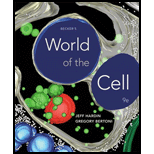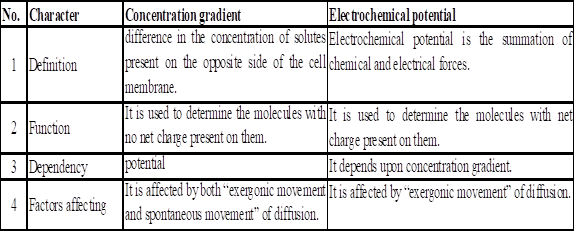
Concept explainers
What is the difference between the concentration gradient and the
To explain: The difference between the concentration gradient and the electrochemical potential.
Introduction: Cell is the basic “fundamental unit” of life. Every organism is composed of a cell. Cells perform cellular activities to maintain their normal functioning. One such important cellular activity is transportation. The process of carrying molecules, gases, organic substances and ions from one part to another part of the cell is termed as transportation. Concentration gradient and the electrochemical potential are two important factors affecting the transportation of solutes across the cell membrane.
Explanation of Solution
The difference between the concentration gradient and the electrochemical potential are as follow:

To explain: The mechanism out of the three types of transport mechanisms which are relevant to the magnitude of the concentration gradient.
Introduction: The process of carrying molecules, gases, organic substances and ions from one part to another part of the cell is termed as transportation. Concentration gradient and the electrochemical potential are two important factors affecting transportation of solutes across the cell membrane. The concentration gradient is used to determine the molecules with no net charge present on them
Explanation of Solution
There are three mechanisms for transportation. These are: Simple Diffusion, Facilitated Diffusion, and Active Transport
The mechanism out of the three types of transport mechanisms that is relevant to the magnitude of the concentration gradient is simple diffusion. This is because only simple diffusion is the transportation method that does not carry any ion. Whereas, both facilitated diffusion and active transport mechanisms transport ions. The concentration gradient is used to determine the molecules with no net charge present on them.
Therefore, the mechanism which is relevant to the magnitude of the concentration gradient is simple diffusion.
To explain: The mechanism out of the three types of transport mechanisms which is important to the electrochemical gradient.
Introduction: The process of carrying molecules, gases, organic substances and ions from one part to another part of the cell is termed as transportation. Concentration gradient and the electrochemical potential are two important factors affecting transportation of solutes across the cell membrane. The concentration gradient is used to determine the molecules with no net charge present on them
Explanation of Solution
There are three mechanisms for transportation. These are simple diffusion, facilitated diffusion, and active transport.
Active transport is a method of transportation in which the solute is transported against a concentration gradient that is from a region of lower concentration to higher concentration. This type of movement requires extra energy as it is performed against a concentration gradient. The mechanism out of the three types of transport mechanisms that is important to the electrochemical gradient is active transport. This is because it is the only mechanism that has a direct relation with the electrochemical gradient. An electrochemical gradient is an important factor for the cause of indirect active transport.
Therefore, active transport is the mechanism that is important to the electrochemical gradient. The reason is that the electrochemical gradient can cause indirect active transport.
Want to see more full solutions like this?
Chapter 8 Solutions
Becker's World of the Cell (9th Edition)
- What is this?arrow_forwardMolecular Biology A-C components of the question are corresponding to attached image labeled 1. D component of the question is corresponding to attached image labeled 2. For a eukaryotic mRNA, the sequences is as follows where AUGrepresents the start codon, the yellow is the Kozak sequence and (XXX) just represents any codonfor an amino acid (no stop codons here). G-cap and polyA tail are not shown A. How long is the peptide produced?B. What is the function (a sentence) of the UAA highlighted in blue?C. If the sequence highlighted in blue were changed from UAA to UAG, how would that affecttranslation? D. (1) The sequence highlighted in yellow above is moved to a new position indicated below. Howwould that affect translation? (2) How long would be the protein produced from this new mRNA? Thank youarrow_forwardMolecular Biology Question Explain why the cell doesn’t need 61 tRNAs (one for each codon). Please help. Thank youarrow_forward
- Molecular Biology You discover a disease causing mutation (indicated by the arrow) that alters splicing of its mRNA. This mutation (a base substitution in the splicing sequence) eliminates a 3’ splice site resulting in the inclusion of the second intron (I2) in the final mRNA. We are going to pretend that this intron is short having only 15 nucleotides (most introns are much longer so this is just to make things simple) with the following sequence shown below in bold. The ( ) indicate the reading frames in the exons; the included intron 2 sequences are in bold. A. Would you expected this change to be harmful? ExplainB. If you were to do gene therapy to fix this problem, briefly explain what type of gene therapy youwould use to correct this. Please help. Thank youarrow_forwardMolecular Biology Question Please help. Thank you Explain what is meant by the term “defective virus.” Explain how a defective virus is able to replicate.arrow_forwardMolecular Biology Explain why changing the codon GGG to GGA should not be harmful. Please help . Thank youarrow_forward
- Stage Percent Time in Hours Interphase .60 14.4 Prophase .20 4.8 Metaphase .10 2.4 Anaphase .06 1.44 Telophase .03 .72 Cytukinesis .01 .24 Can you summarize the results in the chart and explain which phases are faster and why the slower ones are slow?arrow_forwardCan you circle a cell in the different stages of mitosis? 1.prophase 2.metaphase 3.anaphase 4.telophase 5.cytokinesisarrow_forwardWhich microbe does not live part of its lifecycle outside humans? A. Toxoplasma gondii B. Cytomegalovirus C. Francisella tularensis D. Plasmodium falciparum explain your answer thoroughly.arrow_forward
- Select all of the following that the ablation (knockout) or ectopoic expression (gain of function) of Hox can contribute to. Another set of wings in the fruit fly, duplication of fingernails, ectopic ears in mice, excess feathers in duck/quail chimeras, and homeosis of segment 2 to jaw in Hox2a mutantsarrow_forwardSelect all of the following that changes in the MC1R gene can lead to: Changes in spots/stripes in lizards, changes in coat coloration in mice, ectopic ear formation in Siberian hamsters, and red hair in humansarrow_forwardPleiotropic genes are genes that (blank) Cause a swapping of organs/structures, are the result of duplicated sets of chromosomes, never produce protein products, and have more than one purpose/functionarrow_forward
 Human Physiology: From Cells to Systems (MindTap ...BiologyISBN:9781285866932Author:Lauralee SherwoodPublisher:Cengage Learning
Human Physiology: From Cells to Systems (MindTap ...BiologyISBN:9781285866932Author:Lauralee SherwoodPublisher:Cengage Learning Biology 2eBiologyISBN:9781947172517Author:Matthew Douglas, Jung Choi, Mary Ann ClarkPublisher:OpenStax
Biology 2eBiologyISBN:9781947172517Author:Matthew Douglas, Jung Choi, Mary Ann ClarkPublisher:OpenStax Concepts of BiologyBiologyISBN:9781938168116Author:Samantha Fowler, Rebecca Roush, James WisePublisher:OpenStax College
Concepts of BiologyBiologyISBN:9781938168116Author:Samantha Fowler, Rebecca Roush, James WisePublisher:OpenStax College Principles Of Radiographic Imaging: An Art And A ...Health & NutritionISBN:9781337711067Author:Richard R. Carlton, Arlene M. Adler, Vesna BalacPublisher:Cengage Learning
Principles Of Radiographic Imaging: An Art And A ...Health & NutritionISBN:9781337711067Author:Richard R. Carlton, Arlene M. Adler, Vesna BalacPublisher:Cengage Learning Biology: The Dynamic Science (MindTap Course List)BiologyISBN:9781305389892Author:Peter J. Russell, Paul E. Hertz, Beverly McMillanPublisher:Cengage Learning
Biology: The Dynamic Science (MindTap Course List)BiologyISBN:9781305389892Author:Peter J. Russell, Paul E. Hertz, Beverly McMillanPublisher:Cengage Learning





